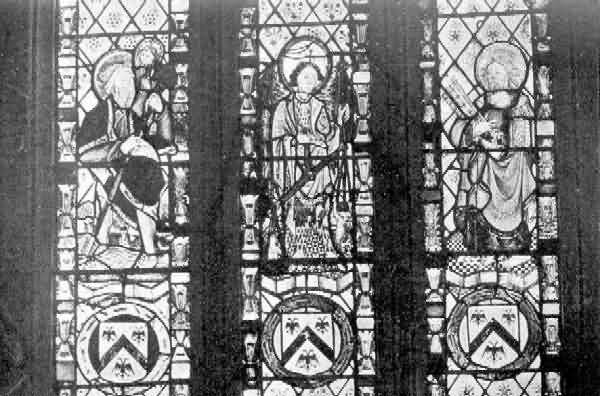
«SOME OLD DEVON CHURCHES» BY JOHN STABB; 85-96
Doddiscombsleigh [85]; Dolton [86]; Dowland [87]; Down St. Mary [88]; Drewsteignton [89]; Dunchideock [90]; Dunkeswell [91]; Dunsford [92]; East Allington [93]; Ermington [94]; Exbourne [95]; Exeter, Heavitree [96].
DODDISCOMBESLEIGH. St. Michael. The church consists of chancel with piscina and priest's door, nave, north aisle, separated from the nave by five arches, south porch, and west tower. The tower screen was erected in memory of the reign of Queen Victoria [1837-1901]. There are some old bench-ends at the east end of the nave. The octagonal font is modern, on an apparently old base, with cable moulding. At the east end of the aisle is the mural tablet in memory of John Babb, who died in August 1697, aged 68; this is the only tablet on the walls. There are some old gravestones in the floor, one to the memory of John Dolling, son of Michael Dolling, who was rector of the parish in Parliamentarian times [1649-1659], and who is mentioned by Walker, in his Sufferings of the Clergy, as one who was often subjected to very cruel treatment. The inscription is as follows:—
Here lyeth the body of John Dolling sonn
of Michael Dolling, Minister, who died
May the 3rd 1662.
"When harder hearts forget thy name
This stone more soft shall keep the same."
The feature of the church is the large amount of old stained glass remaining; there are in all five windows. They were at one time in a very dilapidated condition, but through the kindness of Mr. Clayton (of Messrs. Clayton and Bell), who undertook the work at his own expense, the five windows have been completely restored. It is said that the glass in these windows is second to none in the kingdom; it dates from probably not later than the middle of the 15th century.
On entering the church the window [plate 85a] directly facing us contains in the centre, St. Michael, the Patron of the church, weighing souls; he is depicted holding the scales, with a naked figure in them on the right hand side, and the Devil trying to pull down the balance on his left. The right hand light contains St. Peter with the key, and the left, St. Christopher carrying our Lord over the water. This was always a favourite subject for a church either in window or wall paintings, and was generally placed facing a door, as there was an idea that anyone seeing a picture of St. Chistopher was preserved from sudden death for the day. Much of this window is old glass, although a good portion is modern. The next window contains in the centre light the figure of the Blessed Virgin, on the left St. John with a quill in his right hand, and a chalice with a serpent rising out of it, in his left; and on the right a figure with the hand resting on a sword, probably St. Paul.
The third window [plate 85b] holds the figures of the three saints representing Great Britain; St. Patrick for Ireland on the left, arrayed in mitre and cope; St. George for England in the centre, on horseback, slaying the Dragon; and St. Andrew on the right with the usual symbol, the St. Andrew's cross.
The fourth window (modern) has, on the right, the figure of Edward the Confessor [1042-1066]; in the centre a representation of the Trinity; and on the left, a figure in a pilgrim's hat with scallop shell, a staff in his right hand and a book in his left, and scallop shells on his cloak. This is most probably intended for St. James the Great, as he was often represented in this fashion.
The east window [plate 85c] is the most interesting of the series, being a representation of the Seven Sacraments. The central figure of our Lord, from whose feet, hands, and side radiate red lines to each of the sacraments, is modern, and is the device and the work of Messrs. Clayton and Bell. There was a large deficiency in this window, and it was assumed that it originally contained either a similar figure of our Lord, or a representation of the Crucifixion. Scratched on a pane of blue glass in two places will be found these words:— "Coles, Glaz: done this window March 1764, whom God preserve, Amen." Coles was a well known artist in the 18th century, and was employed a good deal in glazing of the Cathedral windows. The four figures at the top of the window represent four saints: on the extreme left is St. Stephen; the figure with the gridiron is St. Lawrence. At the top of the left light is a representation of the Eucharist; in the centre, Matrimony; at the bottom, Confirmation; at the bottom of the central light, Penance; in the right light at the top, Ordination; the centre, Baptism; and the bottom, Extreme Unction.
The inscription beneath some of the windows is so mutilated that it does not throw any light on their history, the only words remaining which are legible being:— Benefactoribus fenestrum fecit Hugus operis ¾¾¾ fieri fecit.
There are two coats of arms in the windows in the north wall; the three red lions rampant are those of the Chudleighs, who held land in this and the adjoining Parish of Ashton. The three eagles are the arms of the Doddiscombe family. Sir Ralph Doddiscombe, Knt., lived in the Parish of Bishops Nympton, a descendant of his married Symon de Newnham, whose arms, the three eaglets, are in one of the windows.
Under the Seven Sacraments window is inserted a long scroll of stone work with the Babb arms, inscribed thus:— "Faith, Hope, Charity, Providentia Dei Vivimus." It seems to be a sort of headpiece to the family cemetary, many of the members of this family being buried there.
The registers date: baptisms, 1681; marriages, 1682; burials, 1678.
I am indebted to the Rector of Doddiscombsleigh, the Rev. F. F. Buckingham, for much valuable information gleaned from a lecture of his on the church which he kindly lent me.
DOLTON. St. Edmund. The church consists of chancel, nave, north and south aisles, south porch, and west tower with six bells. The nave is separated from the aisles by arches of wide span, resting on short massive pillars. There is a piscina in the chapel and another in the north aisle. At the west end of the nave is a tablet in memory of a former rector of the parish with the inscription:—
To the memory of
William Knaplock
Master of Arts
and of the free school of Credition
Rector of this church
and of himself
ye comfort of his charge in his life
there crosse in his death
which fell fatally
to his friends and family
on ye 8th of October
¾¾¾ 1664 ¾¾¾
ætatis suæ
¾¾ 66 ¾¾
The feature of the church is the old font, composed of two blocks of stone mounted one on top of the other, and carved with interlaced and serpentine patterns. The carved stone, of which the font is made, must be of great antiquity, and most probably formed part of one or possibly two ancient carved shafts, which, from the character of the carving, might date back for a 1000 years or more. When the shaft was converted into a font the upper portion was turned upside down, so to see the carving correctly the illustrations should be held in the same position. On the upper part of the south side [plate 86a] is a human face, an animal, possibly intended for a dragon, issuing from each nostril. On the west side [plate 86b] are two animals somewhat similar in character to those on the south, but they have wings and feet, and there is no human face in the centre of the panel. The eastern side [plate 86c] has two animals, apparently intended for some kind of fish, with their tails crossed and their heads uniting at the top of the bowl. The north side [plate 86d] is carved with the figure of eight pattern on the lower block, and the upper with an effective pattern which is constantly found on early sculptured stones in Great Britain.
The registers date: baptisms, 1608; marriages, 1610; burials, 1608.
DOWLAND. St. Peter ? The church [plate 87a] consists of chancel with priest's door, nave, north aisle separated from the nave by three arches, south porch and west tower with five bells. The church was originally built in 1160, and the dedication though doubtful is supposed to be to St. Peter. The rood screen was removed in 1858. The bells were re-hung during 1885-86; and the inscription on one reads:— "We wish it to be understood, though we are little we're very good."
A feature worthy of note will be found in the pillars supporting the arches dividing the nave and aisle, the half pillars at the east end, and the pillar opposite the south door are of wood, the other is a square block of masonry. The wooden pillars which are of the form as if they were made of stone must have been inserted when the original pillars became decayed.
Inside the south door is a holy water stoup, not as is usually the case sunk in the wall, but a small hollowed out stone attached to it. In the arcade over the wooden pillars can be discerned the remains of an old text, but it has been partially obliterated by a coat of whitewash. The font has an old small octagonal bowl mounted on a later shaft. Some of the bench-ends are very finely carved. One has a scroll with the initials "C.P.", "W.B."; another a crown and crossed keys, another [plate 87b] two heads, one with the tongue standing out, and the finest in the church bears a coat of arms with the words "St. Peter" beneath and the date MDXLVI [plate 87c].
At the end of the aisle are some old tombstones dated 1601, 1612, 1655. There are no old monuments.
The registers date: baptisms, 1743; marriages, 1742; burials, 1742.
DOWN ST. MARY. St. Mary. The present restored church was erected probably in the 14th century, but before this there existed a Saxon church, remains of which can be seen in the present building. The most remarkable of these is to be found in the tympanum of the south door [plate 88a], said to date from Saxon times, and representing a male figure in the centre and animals on either side. The carving has been variously described as Adam naming the animals, Daniel in the lions' den, and as representing one of the legends concerning St. Anthony.
The church consists of chancel, nave, north aisle, south porch, and west tower containing three bells, two dated 1677 and 1754 respectively. As we enter the church we notice the Norman arches and pillars, the latter are monoliths with tracery on the capitals, the font is of granite and of the same date as the pillars, so it would seem probable that the main part of the building is not of later date than the 12th century. The south wall has been entirely rebuilt and faced with stones of various colours. The sanctuary shows signs of the loving care which has been bestowed upon it. There is a beautiful reredos, the walls have been covered with alabaster, and the clergy stalls face eastwards in the old fashion.
The glory of the church is its rood screen [plate 88b]. It was one of the first to be restored in the last century [19th], some portions of the old screen have been preserved, and have been worked into the new. This screen in hitherto published descriptions has not received the notice it deserves; probably because it was restored through the aid of local talent; indeed one account simply says that it has been "roughly restored by the village carpenter". The cresting and cornices are most deliberately carved, and taken as a whole the screen compares favourably with any in Devonshire.
There are some good bench-ends; on one there is a curious figure of a man holding a stick with something at the end, which, it has been suggested, might be intended for grapes, but I do not see the resemblance; it seems to me much more likely that the figure is intended to represent a flagellant [plate 88c].
Another «end» is carved with two heads facing each other, with their lips in close proximity. This may be intended to represent the «Kiss of Peace» [i.e., the greeting reserved for brethren who share the common faith], although the expression on the faces hardly suggests it [plate 88d]. Originally it was not the custom in churches to provide fixed seats for the congregation; there were sometimes stone seats round the base of the pillars, and probably the old and infirm brought their own seats with them. We know that Jenny Geddes used hers [in 1637] to throw at the preacher [the Dean of Edinburgh]. As time went on seats were fixed in the chantry chapels, and from there the custom grew of having seats in the body of the church; by the 15th century the custom had become general. The system of pew rents, or if not the payment for pews, certainly the appropriation of seats by members of the congregation, must have begun fairly early, as the number of seats that are decorated with coats of arms shows that there must have been a considerable number of people who could walk into the parish church on Sunday, and say, "Please move up; this is my seat."
Devonshire churches are almost as famous for their bench-ends as they are for their rood screens, and fine examples will be found at the following places:— Colebrooke, showing the Copplestone arms; Ilsington, with the arms of the Beaumonts and Pomeroys; Rewe, with the arms of Waldham impaling Chiseldon and Seymour; Abbotsham, Alwington, Ashton, Atherington; North Bovey, Braunton, Broadwood Widger, Buckland Monachorum, Christow, Clayhanger, Cockington, Colyton, Doddiscombsleigh, Frithelstock, Hartland, Kenn, Lapford, North Lew, Lew Trenchard, Monkleigh, Ottery St. Mary, Sutcombe, North Tawton, and Woolfardisworthy. There is a great variety in the designs used, sometimes initials are carved, sometimes figures of saints, and occasionally symbols of the Passion.
The tower of the church was wrecked by a hurricane in 1413, and special «indulgences» were granted to those who aided the work of rebuilding. It was again restored by the Right Rev. Bishop Kestell-Cornish, when two bells were added, bringing the number up to five. The general restoration of the church is due to Rev. W. T. A. Radford, who from the year 1843 was rector for 53 years.
The registers date from 1696.
DREWSTEIGNTON. Holy Trinity. The church consists of chancel, nave, north and south aisles, south porch with parvise, and west tower with five bells. The holy water stoup has been preserved and is now used in the vestry as a piscina. The pulpit is Jacobean work [ca. 1603-1625]. There are signs of rood loft door, but the screen has been entirely removed. The font is probably a copy of an older one. The chancel was rebuilt at the restoration of the church in 1864. Over the south door are the arms of Queen Elizabeth [r. 1558-1603] with the initials "E. R."
In the tower are preserved:—
The Ringers Articles.
"Whoever in this place shall swear
Sixpence he shall pay therefore
He that rings here in his hat
Threepence he shall pay for that
Who over turns a bell be sure
Threepence he shall pay theredore
Who leaves his rope under feet
Threepence he shall pay for it
A good ringer and a true heart
Will not refuse ro spend a quart
Who will not to those rules agree
Shall not belong to this belfree."
John Hole, Warden.
The registers date: baptisms, 1557; marriages, 1599; burials, 1599.
DUNCHIDEOCK. St. Michael and All Angels. The church is built of red sandstone, is Perpendicular, and consists of chancel, nave, north aisle, Lady Chapel, south porch, and embattled west tower, 55 feet in height, containing three bells, the first is dated 1700, the second has a legend in Old English type, and the tenor has an invocation to St. John.
The nave and Lady Chapel were restored some twenty-seven years since [ca. 1887] by Sir W. and Lady Waldron; the chancel was restored at the same time.
The Gothic screen [plate 90a] dates from the 15th century, and is complete with doors, groining [plate 90b] and cornice. The feature to which I wish to call attention in this church is the elaborate carving of the pier casing [plate 90c] between the sections of the screen. When the screens were erected in sections between the pillars instead of stretching continuously across the church in front of them, the pillars were naturally left exposed, and it became necessary, if the screen was not to be marred, to cover the pillars with carvings of wood, called pier casings. They vary much in merit, some being most elaborately carved, and others not much more than plain wainscot. The one in this church is a very good example, the workmanship being most delicate. At Combe Martin the casing is provided with niches to hold statuettes, and Harberton has a most elaborate carving for the piers. The rood loft is six feet in width. In former years the south bay of the screen was cut to make room for a «three-decker» pulpit, but since the appointment of the present rector this has been removed and the screen restored. Notice should be taken of the richly carved pier casing. The ancient rood loft staircase can still be seen in the south wall.
For many years the lower portion of the tower was used as a burial place of the Haldon family, but it has now been opened up to the church, and the coffins removed to a vault in the churchyard.
There are fine carved bench-ends, four inches thick throughout the church. There is also a very fine carved oak pulpit, modern, but of good workmanship, that is in complete keeping with the screen. It has been erected in memory of Colonel Lucas, of Dunchideock House, a benefactor of the church, and through whose efforts the restoration of the screen was made possible. The pulpit contains five bays with carved statuettes; in the centre, our Lord seated in the act of teaching; on His right, St. Augustine [died 604], the great missionary to this country; on His left, St Boniface [died 754], the great missionary from this country to the Germans, himself a Devonshire man, born at Credition and educated at Exeter; on the right of St. Augustine, St. Columba [died 597], the great missionary of the North, in his hand the [map of] Cathay or MS. of the Psalter which was the cause of his exile to Iona, from whence sprang the conversion of England. He wears the Celtic tonsure. The fifth niche is still vacant. This may truly be called a missionary pulpit.
The list of rectors is almost perfect from William de Lapeflod to the present day.
The registers date: baptisms, 1538; marriages, 1539; burials, 1540.
DUNKESWELL. St. Nicholas. The church, which consists of chancel, nave, north and south aisles, south porch and west tower, was rebuilt in 1868, and with the exception of the font, does not contain much of interest; the font is, however, worth seeing. It is is circular in shape, decreasing slightly in size at the centre, which is surrounded by a twist pattern, not cable moulding; beneath the twist is a scallop pattern. The upper portion of the font is divided into eight panels; in one there is a figure of a bishop arrayed in chasuble and holding a staff [plate 91a]; next to this is another figure, apparently in chains; there are also represented a king, a lord and a lady, and an elephant. It is difficult to date the font, it might be Norman, but if the elephant was sculptured from life the font cannot be earlier than the 13th century as, according to Matthew Paris [ca. 1200-1259], the first elephant was seen in England in 1255, when King Henry III [r. 1216-1272] received one from Louis IX [r. 1226-1270] of France. It has been suggested that the lord and the lady may be intended for Lord William de Briwere and his wife; he was the founder of Dunkeswell Abbey, died in 1226, and was buried before the high altar of the Abbey church. The presence of an elephant on a font is appropriate, as there was an ancient belief that the elephant brought forth her young in the water, and the animal thus became a symbol of the new birth in the water of baptism. The carvings on the font are much worn and difficult to make out; the elephant will be found on the west side [plate 91b].
The registers date: baptisms, 1750; marriages, 1743; burials, 1740.
DUNSFORD. St Mary. The church consists of chancel, with piscina and priest's door, nave, north aisle, south porch, and west tower with six bells. There is a west gallery with organ, and beneath the gallery an oak screen across the tower entrance.
Fulford House must have existed for a great many years, for we find that, on July 8th 1402, Bishop Stafford granted a licence to Henry Fulford and Wilhelmina his wife for the performance of Divine Service "infra mansionis suas de Ffoleford et Morton." The Manor of Dunsford, which had previously beonged to the Priory of Canonsleigh, was purchased by Sir John Fulford at the Reformation. The present house was built by Sir John Fulford, who was Sheriff of Devon in the 5th year of Queen Mary [1553-1558], and the 19th of Queen Elizabeth [1558-1603]. The parish church is the burial place of the Fulford family, and the tomb [plate 92a] is a good example of richly decorated work of the Jacobean period [1603-1625]; on the base are the life-size figures of Sir Thomas Fulford and his wife Ursula. The male figure is arrayed in steel armour picked out in gold. He wears an Elizabethan ruff and wristbands, and a red velvet tunic and pantaloons; the head and hands are bare. His wife wears a dress of the same period with a trimming of gilt quatrefoils down the front, a ruff and flat head-dress. On a ledge at the back of the tomb kneel their children; the first figure in the row kneels before a desk. On the tomb is a shield with the arms of Fulford impaling Bamfield. The inscription is as follows:—
Heare lye Sir Thomas Fulforde
who died last day of july ano do 1610
Also his wife Ursula, who died 1639
daughter of Richd Bamfield, of Poltimore, Esq.
Their Children
1st Sir Francis, who married Ann heir of Bernard
Samways Esqr of Toller Dorset
2nd William, 3rd Thomas, 4th Bridget married to
Arthur Champerknowne Esqr of Dartington;
5th Elizabeth married to John Berriman Esq,
6th Ann, married to John Sydenham, of Somerset
The church also retains one of the old west galleries [plate 92b] which are so rapidly disappearing under the hand of the restorer.
In the chancel is a bishop's chair elaborately carved [plate 92c]. The only information I can obtain about it is that it is said to have been brought some years ago, from Culver House by a former vicar, Rev. Stephens, a son-in-law of Bishop Philpotts [elected 1831], who used to reside at Culver House until he built the present vicarage.
There is an octagonal font with shields of arms. It is modern, but is said to be a correct copy of the ancient one. The reredos is of stone, and so is the comparatively modern chancel screen [plate 92d], which consists of a central doorway, with two rectangular openings on each side divided into two bays; the upper portions filled with tracery, and the spandrels pierced; over the lights is a cornice, surmounted by a battlemented cresting.
There are some coloured bosses in the chancel roof. The church was restored and the chancel rebuilt in 1840, at a cost of £1,100.
The first vicar was Thomas de Bonville.
The registers date: baptisms, 1597; marriages, 1594; burials, 1594.
EAST ALLINGTON. St. Andrew. The church [plate 93a], consisting of chancel, nave of five bays, north and south aisles, south porch with circular headed doorway and holy water stoup, and west tower with five bells, is a fine Perpendicular building. The rood screen is finely carved in very dark oak and bears the arms of the Fortescues and other families who intermarried with them. The groining is gone, and spandrel spaces are filled with the remains of the old carving. On one of the panels is the date of its erection, 1547. The tracery of the upper part is Perpendicular, but the panels below appear to be made up of miscellaneous pieces of carving, presumably old bench-ends. There are north and south parclose screens of good design. The alabaster reredos, the work of Mr. H. Hems of Exeter, is handsome, a former font also of alabaster was spoilt, the precaution not having been taken of lining it with lead, and the water soaked into the stone. The east window is in memory of Mrs. Fortescue of Fallapit. There is a handsome monument of the Fortescue family by Chantrey [1781-1841]. The baptistery and west window were presented by Mrs. Cubitt in 1892 as a memorial of her husband.
The pulpit of oak, octagonal in shape and elaborately carved [plate 93b], resembles in many respects the pulpit in the parish church at Dartmouth. The body bears Tudor characteristics; the billeted cornice round the top is Jacobean, and was probably added later. On the panels are carved the Prince of Wales' feathers, the harp, portcullis, rose, thistle, fleur-de-lis, unicorn and lion; there are also shields bearing the arms of the Fortescue family.
Some good brasses remain in the church, one represents two standing figures, with the hands closed in prayer, and bears the following inscription:—
Here lyeth buried the bodies of John
Fortescue, and Owner, his wife, which
John deceased xxvth daie of December
ano 1595 beinge the age of ¾ years.
And the said Owner deceased the ¾ day
of ¾ ano domini ¾ beinge of the age
of ¾ years.
The wife was buried on September 8th 1606, but the spaces have never been filled in.
A second brass represents a woman kneeling with hands clasped in prayer and wearing a wimple, this was probably Elizabeth wife of Lewis Fortescue, Baron of the Exchequer in the reign of Henry VIII [1509-1547].
There is a stone monument with two figures kneeling on cushions on either side of a low pedestal which supports a shield. The man is in armour, the woman in a loose gown. This monument is said to commemorate John Fortescue, who died in 1649, and his wife Sarah, daughter of Sir Edward Prideaux, who died 1628. There is a brass plate with inscription attached to the monument, but it does not belong to it, and for a long time it was lying loose in the church.
The registers date: baptisms, 1554; marriages, 1555; burials, 1554.
ERMINGTON. St. Peter and St. Paul. The church consists of chancel, nave, north and south aisles, and west tower surmounted by a tall spire considerably out of the perpendicular, the inclination is said to have been caused by lightning.
At one time a remarkable feature in this church was the position of the altar, which stood some six or seven feet away from the chancel wall and was surrounded by a massive Jacobean balustrade of oak. This has been removed and the altar placed in its usual position at the east end of the chancel. In the north chancel aisle is the Elizabethan monument of Christopher Chudleigh of Ashton [1528-1570], there is also a brass of the Strachleigh family, 1853.
The chancel screen is a handsome Jacobean erection with a well carved cornice supported by moulded balusters [plate 94]. It is surmounted by a plain cross. There are also north and south parclose screens similar in some respects to those at Ugborough and Holbeton. The screen has been restored by the Misses Penwill, the vicar's daughters, who are also the restorers of Manaton and other Devonshire screens. The clergy stalls face eastwards. The pulpit and font cover are modern, the font is Norman.
The registers date: baptisms, 1603; marriages, 1605; burials, 1603.
EXBOURNE. St. Mary. The church consists of chancel, with priest's door, nave, south aisle divided from nave by three arches, resting on granite monoliths, south porch, and west tower. The arch of the tower is said to be the most ancient portion of the existing building, it most probably dates from the 13th century. In the chancel wall is an opening, apparently a piscina, but too low for that purpose as the floor level is at present; probably the chancel floor has been raised.
There is an interesting rood screen [plate 95] with good detail and of early date. It has open traceried arcades, the spandrels being pierced, the lights are rectangular as at Bow and Calverleigh, and the screen originally supported a flat coving instead of the more usual groining. The screen was taken down in 1835 and stored. In 1889 it was restored to its proper position after undergoing repair. The date of the screen is said to be about 1420. There are some remains of ancient gilt and colour; most of the lower panels are new and plain, but one or two show faint traces of paintings. There is a cornice of two rows of leaves and grapes, and a low cresting; the doors remain. An inscription states the screen was restored:— To the honour and glory of Almighty God and in memory of many whose remains are interred within and around these walls — on whose souls may God have mercy — this screen erected circa A.D. 1440-50, and removed about the year 1836 was restored to its place A.D. 1899.
The church has been restored and has some good modern carved bench-ends, amongst the subjects will be found: the emblems of the Passion; a grape vine; the thistle; the arms and initials of Archbishop Temple [elected 1896]; H. E. R. Exon (Bishop Ryle); V. R. I. 1837-91. The seats were given by Miss Hole in memory of Emily Francis Hole, widow of the Rev. Nathaniel John Brassey Hole, Rector of Broadwood Kelly. The south aisle retains its high pews. The pulpit is old, it bears the date 1665, a peculiarity about it is that it is entered direct from the vestry.
In the floor of the nave is a stone with the following inscription:— Here lyeth the body of Richard Downe son of William Downe of this Parish who was here buried the 16th day of December, Anno Domi 1710.
"In speechless
Silence my youthful
Daye soon sped I
Left my cradle and
Come here to bed."
There is a good west door, square-headed, with the spandrels carved, and an empty image niche above; there is another image niche close to the south door of the church, and also a holy water stoup. In the church is preserved the old «stock box» with two locks, and banded with iron. Sometimes these boxes were the property of some particular guild connected with the church, but more often they belonged to the parish, and were used for keeping the parochial money called «Church Stock».
The first vicar seems to have been William de Mules, 1266.
The registers date from 1540; and the churchwardens' accounts are in unbroken succession from the time of Charles II [1660-1685].
EXETER, HEAVITREE. St. Michael. The church [plate 96a] is believed to have been appropriated to the Cathedral Church of Exeter in 1152 by Pope Eugenius III [elected 1145]; it was altered or rebuilt in the 15th century, and again in 1541; in 1846 the church, with the exception of the tower, was entirely rebuilt. In 1887 the old tower was removed, and new one erected in commemoration of the Jubilee [of Queen Victoria], and in 1893 the chancel was enlarged. The present building consists of chancel, nave, north and south aisles, south porch, and west tower. The nave is separated from the aisles by six arches, supported on pillars with richly carved capitals; these capitals are best studied from the galleries on each side of the church. At the south end of the nave, one of the capitals has a carving of a jester in fool's cap, and with tambourine; at the north-west end of the nave a bishop's head is carved on one of the capitals. On the third arch, of the south side, is a shield with the Courtenay arms; it probably dates from the 14th century. The waggon shape roof is supported on brackets, carved with angels, bearing shields with armorial bearings. The font, pulpit, and lectern, are modern work. Some remains of the ancient screen have been incorporated in a handsome south parclose screen [plate 96b]. In Dr. Oliver's time [ca. 1830] there were remains of the screen across the north aisle, later on, this was taken to the west end of the church. Quite recently these remains have been restored and placed as a dwarf screen to the south chapel. There are 10 painted panels, the subjects on which have been variously described, but I do not think there is much doubt that they are intended to represent Sibyls [ancient Greek prophetesses]. Mr. Bligh Bond describes them as:—
A. 1. Sibylla Delphica (with crown of thorns).
2. Sibylla Hellespontina (with cross and reed or trident).
3. Sibylla Tiburtina (?) or Cimmeria (with three nails).
4. Sibylla Libyca (with column of flagellation).
B. 1. Sibylla Cumana (with sponge on reed).
2. Sibylla Agrippa (with the scourge).
3. Sibylla Europa (with sword).* (* This might be Sibylla Erythrea. J.S.)
4. Sibylla Gaucia (with cradle).
C. 1. St. Agatha (with sword through her breast).* (* This might be St. Justina. J.S.)
2. St. Lucy (with sword through her neck).
There are some old tombstones at the east end of the nave, one in memory of Thomas Gorges, of Heavitree, and his wife Rose, has the inscription:—
Hee departed this life 17th October 1670
and shee the 14th day of April 1671
"The loving turtle having lost her mate
Begged shee might enter ere they shut the gate
Their dust here lies whose soules to Heaven are gone
And waite till Angels rowle away the stone."
The name of the first vicar was John de Christenstowe, date 1280.
The registers date: baptisms, 1556; marriages, 1654; burials, 1653.

Doddiscombsleigh: St. Christopher Window
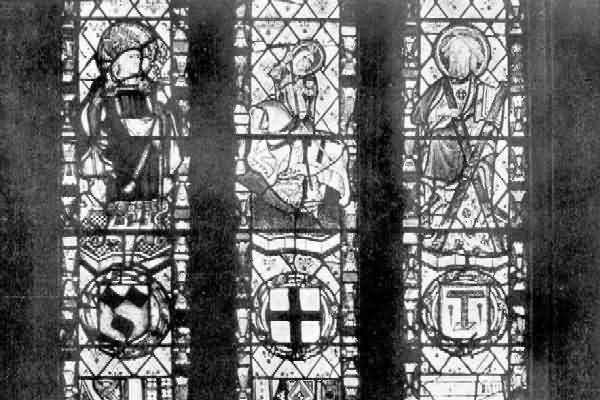
Doddiscombsleigh: St. George Window
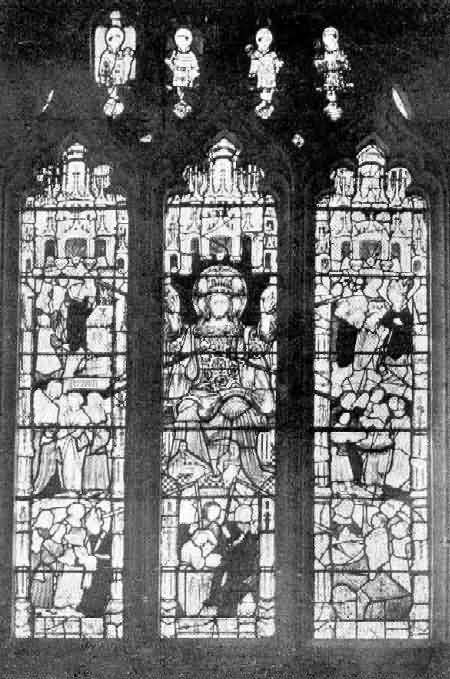
Doddiscombsleigh: Seven Sacraments Window
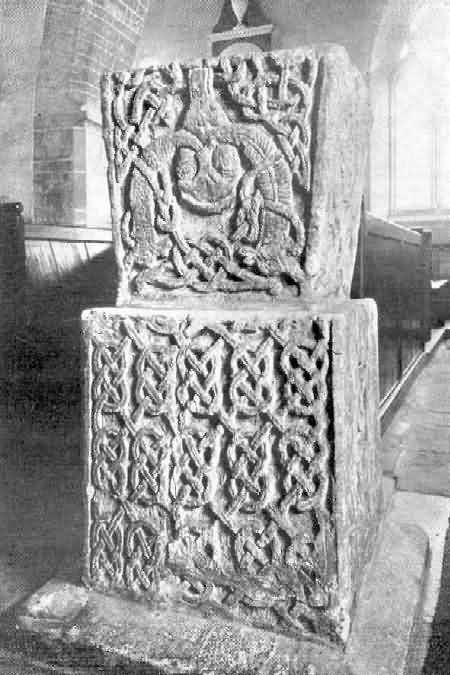
Dolton: Font, South Side
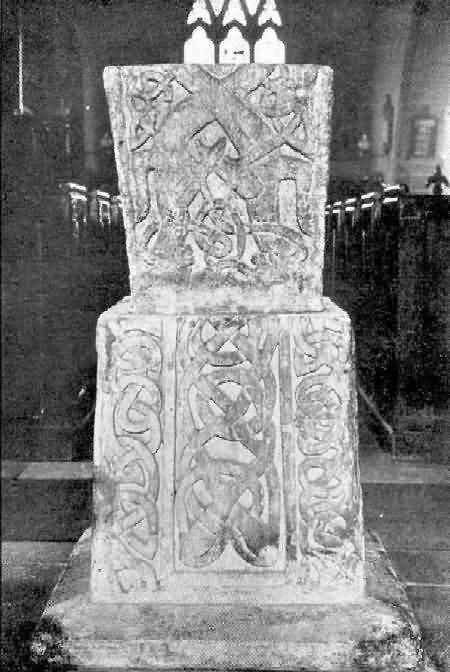
Dolton: Font, West Side
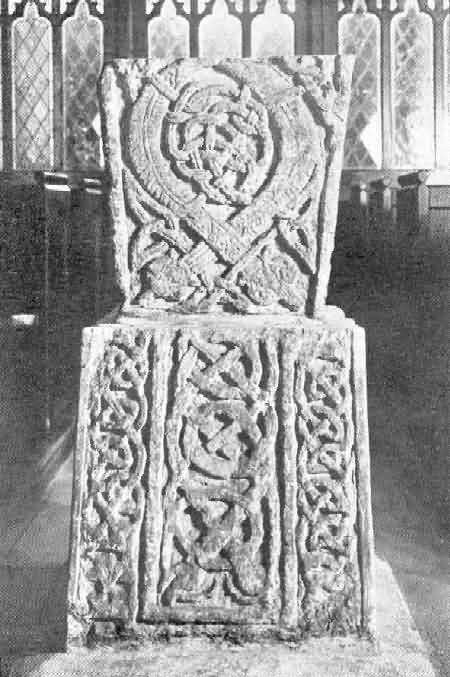
Dolton: Font, East Side
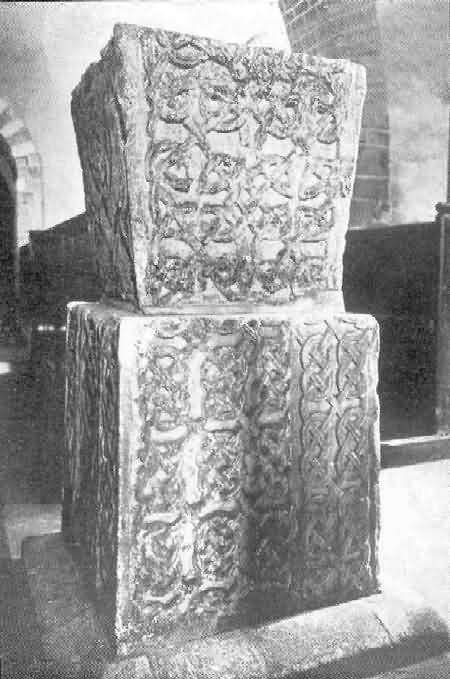
Dolton: Font, North Side
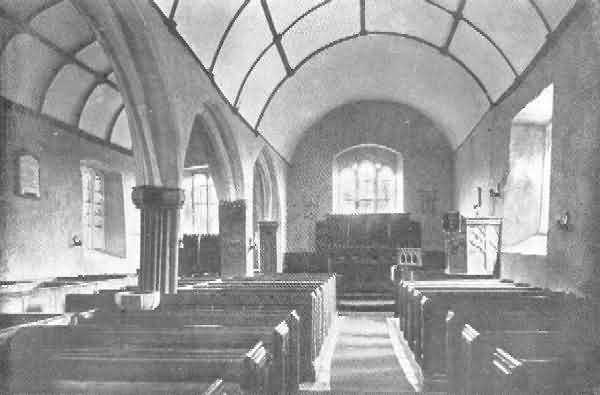
Dowland: Interior
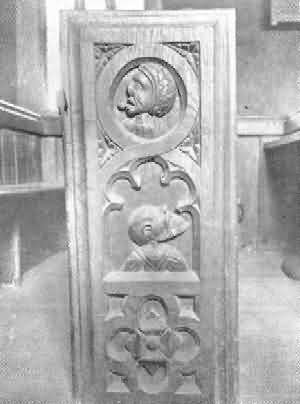
Dowland: Bench-End, 1
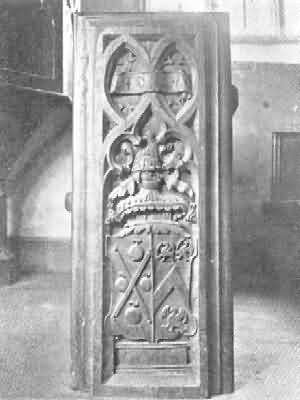
Dowland: Bench-End, 2
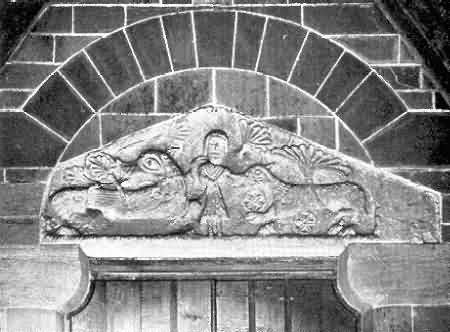
Down St. Mary: Carving on Typanum of South Door
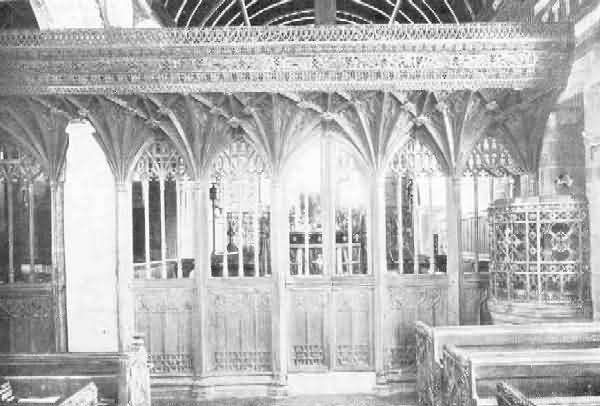
Down St. Mary: Rood Screen
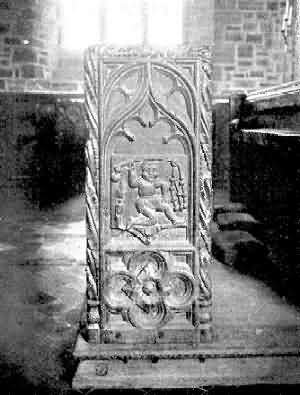
Down St. Mary: Bench-End, 1
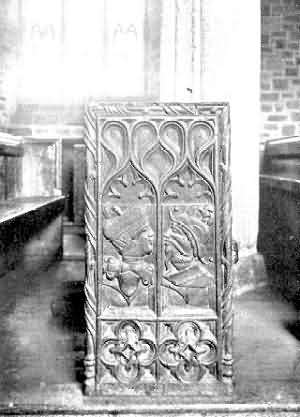
Down St. Mary: Bench-End, 2
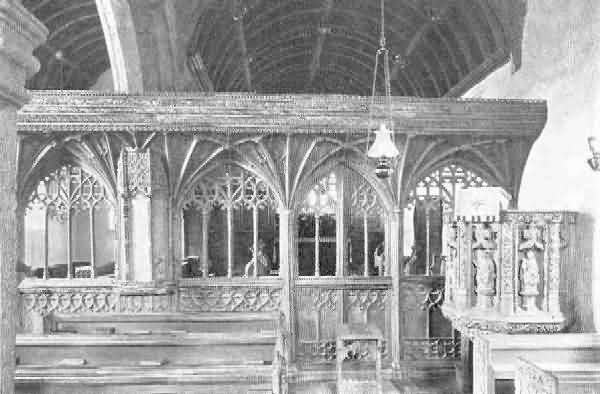
Dunchideock: Rood Screen
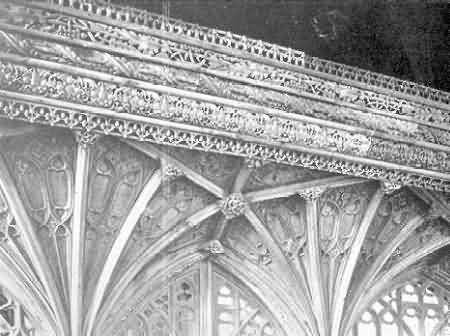
Dunchideock: Detail of Carving on Groining
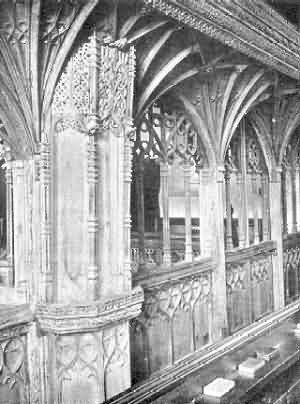
Dunchideock: Carving of Pier Casing
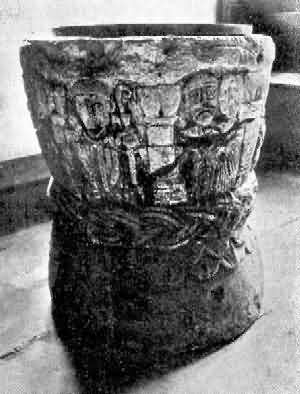
Dunkeswell: Font, North-East Side
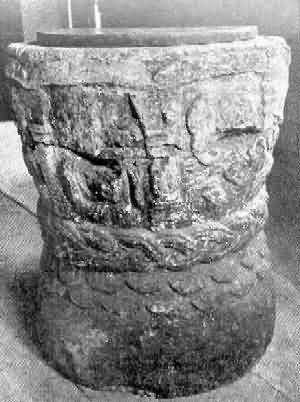
Dunkeswell: Font, West Side
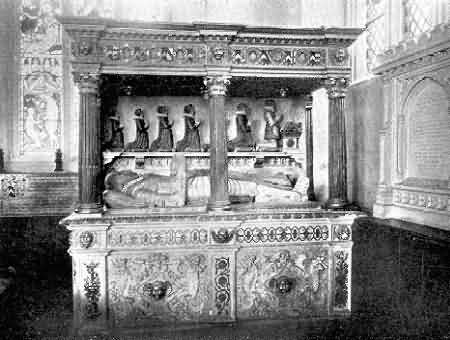
Dunsford: Fulford Monument
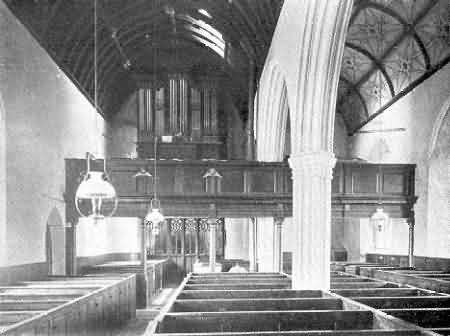
Dunsford: West Gallery
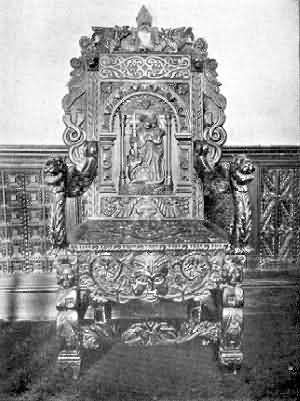
Dunsford: Bishop's Chair
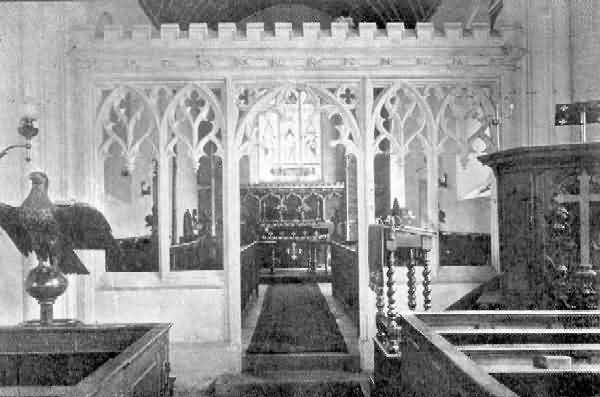
Dunsford: Stone Chancel Screen
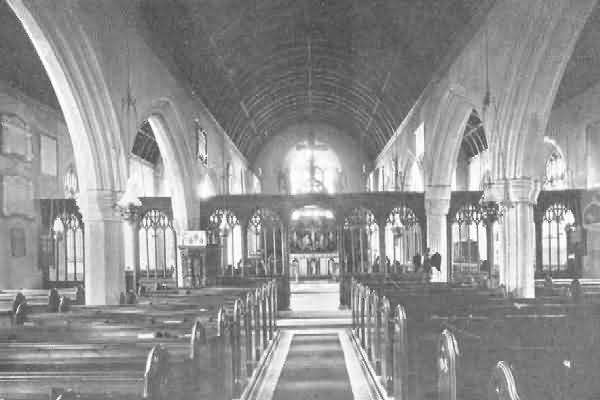
East Allington: Interior
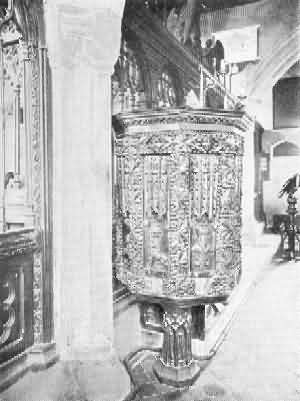
East Allington: Pulpit
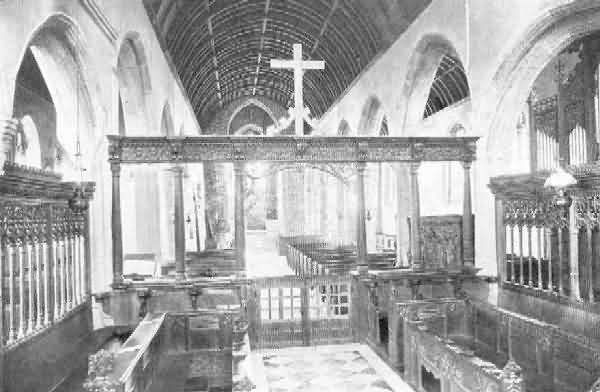
Ermington: Rood Screen
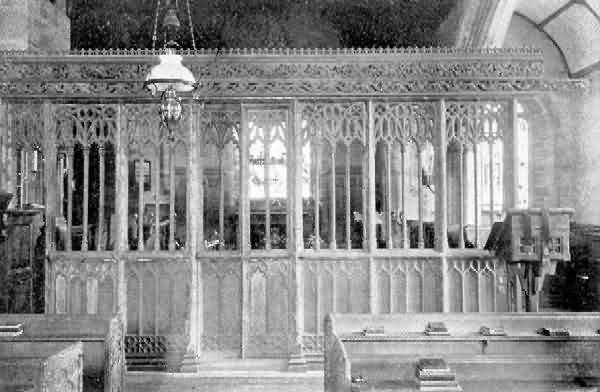
Exbourne: Rood Screen
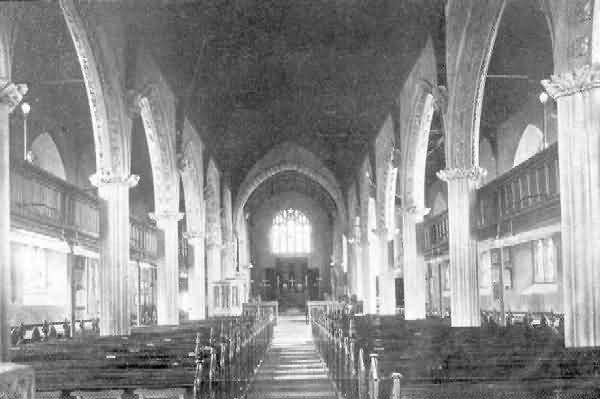
Exeter, Heavitree: Interior
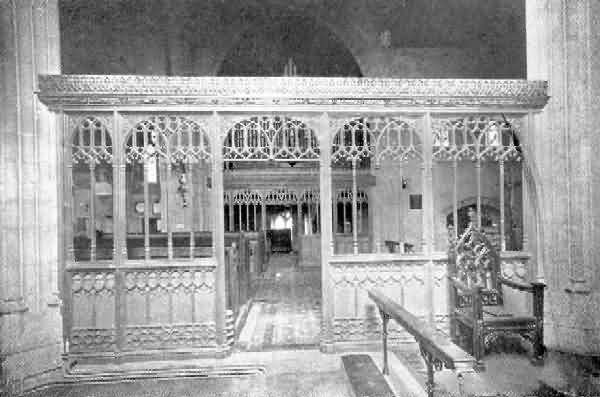
Exeter, Heavitree: Parclose Screen
«Some Old Devon Churches»:
Index; 97-108
[Dr. R. Peters: rpeters@wissensdrang.com]